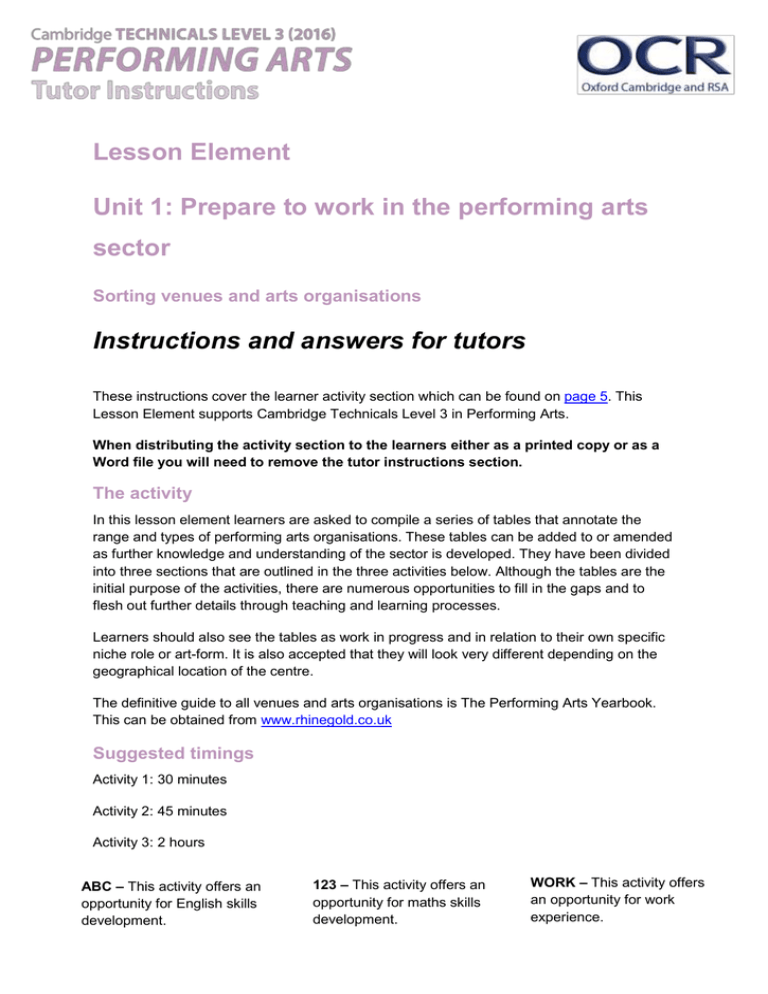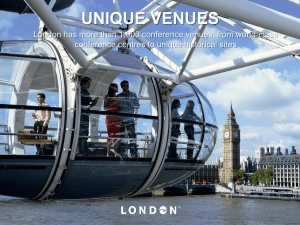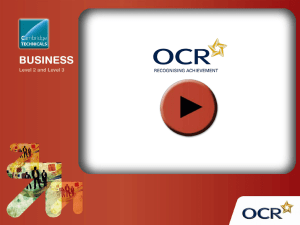Unit 01 - Lesson element - Sorting venues and arts organisations (DOC, 483KB)
advertisement

Lesson Element Unit 1: Prepare to work in the performing arts sector Sorting venues and arts organisations Instructions and answers for tutors These instructions cover the learner activity section which can be found on page 5. This Lesson Element supports Cambridge Technicals Level 3 in Performing Arts. When distributing the activity section to the learners either as a printed copy or as a Word file you will need to remove the tutor instructions section. The activity In this lesson element learners are asked to compile a series of tables that annotate the range and types of performing arts organisations. These tables can be added to or amended as further knowledge and understanding of the sector is developed. They have been divided into three sections that are outlined in the three activities below. Although the tables are the initial purpose of the activities, there are numerous opportunities to fill in the gaps and to flesh out further details through teaching and learning processes. Learners should also see the tables as work in progress and in relation to their own specific niche role or art-form. It is also accepted that they will look very different depending on the geographical location of the centre. The definitive guide to all venues and arts organisations is The Performing Arts Yearbook. This can be obtained from www.rhinegold.co.uk Suggested timings Activity 1: 30 minutes Activity 2: 45 minutes Activity 3: 2 hours ABC – This activity offers an opportunity for English skills development. 123 – This activity offers an opportunity for maths skills development. WORK – This activity offers an opportunity for work experience. Activity 1 As a preliminary task to this activity learners could be asked to list all the venues and performance spaces within their locality. This could be done as part of a leaflet/flyer collecting exercise or just from their own local knowledge. The intention is to get a definitive list of all the places within the local area that host any form of performance activity. You should ask them to make a table that identifies whether each of the venues is local, regional or national in its outlook and policy. Other factors that you may choose to use to define these three categories could be; the mix of the audience, how and where they advertise and actively seek new audiences, and what they are funded for. A completed table is included below, this is intended as an example and relates to Leicester and the East Midlands, so should be adapted to the centre’s needs. One way of approaching this activity is to have a list of companies and venues written on the white board or on cards, learners could then allocate each company to one of the three categories. Local Little Theatre – Amateur Phoenix - Film mostly but with some digital performance Regional National Derby Theatres – includes Derby Playhouse, Guildhall and Assembly Rooms Nottingham Playhouse Peepal Centre – Arts Centre addressing a diverse cultural mix Upstairs at the Western – Pub theatre Leicester College – mostly student productions De Montfort University – student productions but with some touring companies Leicester Curve Theatre Djanogly Arts Centre, Nottingham – large arts centre that has a regional profile, mainly because it is in Nottingham, the ‘capital’ of the East Midlands region Curve and Nottingham Playhouse will market some productions nationally as they will go on to perform in London or in conjunction with other regional theatres (ie Chichester), this doesn’t make them ‘national’ in the same way the following are: National Theatre Royal Shakespeare Company Royal Ballet/Opera House Northampton Theatres Ballet Rambert New Perspectives The Musician – Pub/Music venue Some companies are funded to tour nationally: De Montfort Hall – Local authority concert hall/multi-use space Kneehigh English Touring Company Y Theatre – small scale touring/comedy venue Embrace Arts – inclusive and accessible arts centre Version 1 2 Copyright © OCR 2015 Activity 2 As part of previous activities learners have been asked to brainstorm the venues that they know exist in their local area. (If learners say Vue or Showcase it should be pointed out that these do not count as we are sorting live performing spaces or venues). Venues mentioned could be sorted into: Local Arts Centres – spaces where touring companies/comedians or musicians perform (Receiving). Regional Theatres – generally doing plays, musical theatre or dance performances (Receiving/Producing). Music venues – which could be pubs or larger multi-use spaces (Arenas). Other – in schools and colleges, community centres, village halls (small scale touring venues). Learners could then be asked to fill in the table below. This can also include any other theatres or performing companies that they know about, have come into contact with or are given out as part of the session. Some examples are given. Good source books for this kind of sorting are Contacts (www.spotlight.com) and The Performing Arts Yearbook (www.rhinegold.co.uk) Receiving Arts Centre Producing Multiuse/Arena Touring company Music venue Buxton Opera House Warwick Arts centre RSC NEC Forced Entertainment Digwalls Activity 3 You could lead learners in a discussion on funding and the different ways in which arts organisations receive this. The ‘bottom line’ is probably the place to start this discussion: What do performing companies/venues need to survive? Money – audiences – good shows – more audiences. Version 1 3 Copyright © OCR 2015 Alternatively it could be a starting point to indicate that the public is the ultimate source for all funding, either directly through box office receipts or taxes. The form of income can be categorised in various ways and the table below asks learners to consider these categories and give examples of companies and venues that will fit some of these categories. If the companies fit more than one, then it will become clear that they need a mixture of funding sources – most funding organisations will insist on this anyway. A good place to start with funding is to see what logos are placed on the bottom of posters and flyers. Learners should also be told the difference between revenue funding and project funding. Type of funding Box office (Commercial) Public sector Private sector Third sector Examples of funders Audience Arts Council Private Benefactors Charities Advertising in programmes Local Authorities Trusts Sponsors Associated products (mugs, t-shirts etc) Examples of receiving organisation West End theatres RSC Start-up touring companies Royal Opera House Some shows in subsidised theatres – Pantos, commercial tours (These are revenue funded) Some festival venues have private sponsorship: Dave Leicester Comedy Festival Some schools touring companies will work with charities to pass on specific issues/messages English Touring Company Small scale touring companies (These are usually project funded) We’d like to know your view on the resources we produce. By clicking on ‘Like’ or ‘Dislike’ you can help us to ensure that our resources work for you. When the email template pops up please add additional comments if you wish and then just click ‘Send’. Thank you. If you do not currently offer this OCR qualification but would like to do so, please complete the Expression of Interest Form which can be found here: www.ocr.org.uk/expression-of-interest OCR Resources: the small print OCR’s resources are provided to support the teaching of OCR specifications, but in no way constitute an endorsed teaching method that is required by the Board, and the decision to use them lies with the individual teacher. Whilst every effort is made to ensure the accuracy of the content, OCR cannot be held responsible for any errors or omissions within these resources. © OCR 2015 - This resource may be freely copied and distributed, as long as the OCR logo and this message remain intact and OCR is acknowledged as the originator of this work. OCR acknowledges the use of the following content: Maths and English icons: Air0ne/Shutterstock.com Please get in touch if you want to discuss the accessibility of resources we offer to support delivery of our qualifications: resources.feedback@ocr.org.uk Version 1 4 Copyright © OCR 2015 Lesson Element Unit 1: Prepare to work in the performing arts sector Learner Activity Sorting venues and arts organisations As part of your research on performing arts organisations you will be asked to compile a series of tables that place performing arts organisations in categories according to: Bullets Their geographical profile and community served. Type of venue and/or company. Method of funding. You can make notes on each entry into the tables especially where you feel that the venue or company can fit into two or more categories or where it is difficult to exactly categorise. Activity 1 Starting with those you know already in our own locality you should make a list of as many different performance companies and types of venue as you can think of. Remember to include music venues as well as school theatres, amateur theatres and any companies you have seen as part of touring programmes. Don’t worry about who is funding these companies or whether they get any funding at all, just consider where they find their audiences and whether they have a strong link to the area or whether they just use it as a base. These companies will then be categorised by you as local, regional or national and placed in the columns in the table. Version 1 5 Copyright © OCR 2015 Local Version 1 Regional 6 National Copyright © OCR 2015 Activity 2 For this activity you will be asked to sort venues and performing companies into types: Receiving theatres. Arts Centres. Producing theatres. Multi use space/arena. Touring company. Music only venues. We will look at various sources for this information but we will also talk about what we can understand from the type of performances venues put on in our own locality. Often we will be able to work out from posters and marketing flyers whether a theatre or venue has produced their own work or are receiving a touring production. Some venues such as Arts Centres and multi-use spaces will clearly advertise a wider range of arts and music events. Receiving Arts Centre Producing Multiuse/Arena Touring company Music venue Activity 3 During this lesson we will talk about funding and the ways in which funders determine who gets what! There are very specific rules and conditions for companies and artists to receive any kind of funding and this usually has to do with the building of new audiences, who the funding will ultimately benefit and the legacy of the project. These rules can change from year to year as priorities in society change generally. There are four types of funding to consider: Commercial (Box Office, commercial activities). Public sector. Private sector. Third sector. We will consider what defines these different kinds of funding as well as looking at differences in types of funding (revenue and project). Version 1 7 Copyright © OCR 2015 As a start you should begin to look at the table below. All companies that receive any kind of external funding (other than commercial) will have to place the funder’s logo on publicity. You could start by looking for these logos on flyers and websites. Type of funding Box office (Commercial) Public sector Private sector Third sector Examples of funders Examples of receiving organisation Version 1 8 Copyright © OCR 2015


